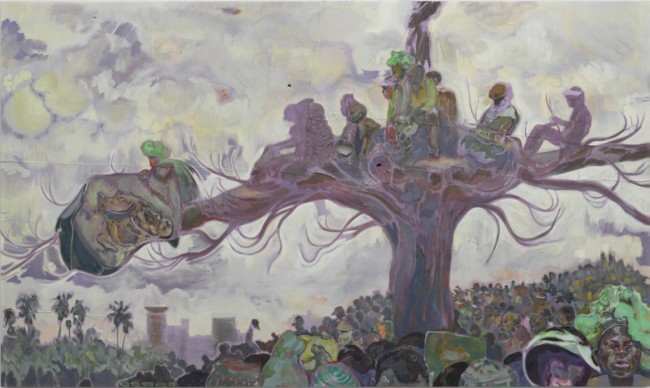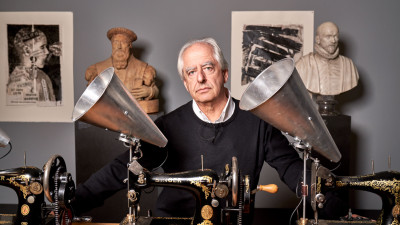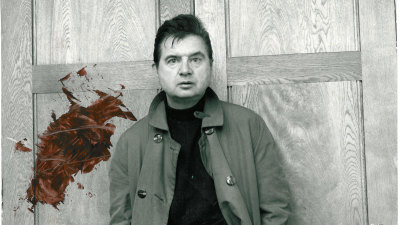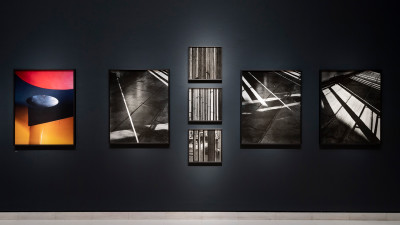A beginner’s guide to Michael Armitage
A beginner’s guide to Michael Armitage
Published 21 May 2021
Get to know an exciting force in painting and how his work is rooted in an East African tradition.
-
-
He weaves together memories, current events and art history
In his paintings Armitage weaves together his experiences in Kenya and current events with contemporary East African art and European art history. With his multi-layered narrative paintings, Armitage questions social norms, religious ideology, politics and cultural clichés.
For instance in his painting Mydas, Armitage interprets the classical legend of King Midas, who turned anything he touched into gold, as something more ambiguous:
“Midas was a ruler with such good intentions… His wish… wasn’t just about greed. It was also about helping his people in a time of drought. …I wanted to set this painting somewhere in northern Kenya, an area that’s prone to drought, where there are a lot of very difficult day-to-day lives and politics, and where you could almost imagine somebody trying to give up everything for a solution—no matter how complicated and problematic…”

-
-
-
He’s Kenyan-British
Armitage was born to a Yorkshireman father and Kikuyu mother, spending his childhood in East Africa before training as an artist in Britain.
He has since described his education at the Slade School of Fine Art and the Royal Academy Schools as “stripping everything back to the basics and building it back up again, which was essential, if not enjoyable.”
His work has been influenced by these years of studying Western art history, and particularly by Paul Cézanne, Edgar Degas, Francisco Goya, Edouard Manet and Titian, but is grounded in East Africa and inspired by artists such as Jak Katarikawe, Chelenge van Rampelberg and Meek Gichugu. He now works between Kenya and London.

-
-
-
He paints on Lubugo bark cloth
Lubugo bark cloth is used by the Baganda people in Uganda in burials, and is traditionally made from the inner bark of the Mutuba tree, or Natal fig. Lubugo bark cloth is the result of an incredibly time-consuming and sophisticated process.
Armitage first came across the material while browsing a tourist stall in Nairobi, where he found the cloth being sold as placemats. At the time, Armitage was experimenting with different materials on which to paint, and was intrigued by Lubugo bark cloth. He then researched it and learnt that it was a material of great cultural importance but that it had been appropriated for the tourist trade and stripped of its significance.
As he experimented with painting on the material he embraced the beauty of its irregularities, holes and seams. In choosing to paint on Lubugo bark cloth instead of canvas, he reinvests the material with new significance and destabilises traditional notions of painting.

-
-
-
His works are rooted in East Africa
In the run-up to the 2017 elections in Kenya, Armitage joined a local TV crew filming an opposition party rally in Uhuru Park, Nairobi. The atmosphere he experienced there, and the carnivalesque scenes he witnessed, inspired a series of paintings in which Armitage explores power dynamics and the links between religious rhetoric, pathos and politics.
While attending the rally, his attention was drawn to a colourful group of opposition supporters sitting in a tree above the crowd, which inspired The Fourth Estate. In this painting, one of the supporters holds a banner of a toad, a symbol that reappears throughout Armitage’s work in this series. The toad could allude to a political deceit, while the title of the painting references the power of the press to influence elections.
Armitage has also acknowledged Francisco Goya as a source of inspiration for his work, and this painting references the artist’s print Disparate ridículo (‘Ridiculous Folly’, c. 1816). Goya’s print has been interpreted as a comment on human irrationality and delusion.

-
-
-
He explores the idea of paradise
The contested elections in Kenya in 2017 led Armitage to think about the allure of paradise after politicians made biblical allusions with their vow to lead Kenyans to ‘the promised land’.
The result is Paradise Edict, which lends its name to the exhibition. In this painting, Armitage challenges the stereotype of the colourful tropical landscape often promoted in tourist brochures. The monumental landscape evokes the island of Kiwayu on the coast of Kenya near Somalia, which Armitage overlays with fantastical scenes of violence, suggesting a more complex narrative.

-
-
He’s indebted to an East African artistic tradition
In his exhibition at the Royal Academy, Armitage has chosen to present works by East African artists whom he considers have played an important role in shaping figurative painting in Kenya and who have had a great impact on his artistic development. These artists include Meek Gichugu, Jak Katarikawe, Theresa Musoke, Asaph Ng’ethe Macua, Elimo Njau and Sane Wadu.When discussing his debt to these artists, Armitage has said: “not only [do] I share many of their socio-political concerns, but the way they [use] Christian imagery and different aspects of local cultures [is] so similar to what I [am] doing.”
Armitage has also selected works by three Kenyan artists – Wangechi Mutu, Magdalene Odundo and Chelenge van Rampelberg – that will be displayed just outside the exhibition galleries. This display invites conversations between the three artists’ works and sculptures from the RA’s collection, which were curated by Richard Deacon RA.
Armitage has solidified his commitment to East African contemporary art by founding the Nairobi Contemporary Art Institute (NCAI), a non-profit visual arts space where a selection of these works will be exhibited as a separate show titled Mwili, Akili na Roho (Body, Mind and Spirit).
-

Jak Katarikawe, (Our Princess, Princess Bagaya), before 1998.

Asaph Ng'ethe Macua, Split Personalities.

Sane Wadu, My life, 1980–1990.

Meek Gichugu, No Erotic Them Say.
-
-

Michael Armitage: Paradise Edict
22 May — 19 September 2021
This year – just over 10 years since Armitage graduated from the RA Schools – we bring together 15 of his large-scale paintings from the past six years, exploring East African landscapes, politics and society.
Alongside these will be a selection of 31 works by six East African contemporary artists: Meek Gichugu, Jak Katarikawe, Theresa Musoke, Asaph Ng’ethe Macua, Elimo Njau and Sane Wadu.
-













